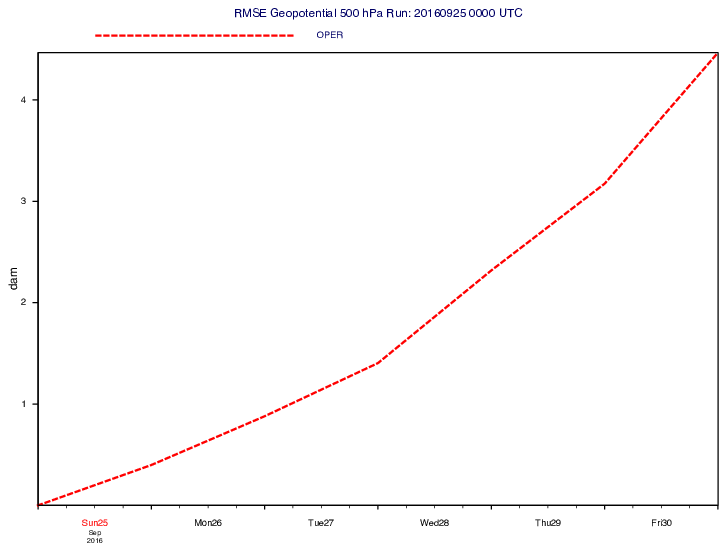Note
Click here to download the full example code
GRIB - RMSE Curve

# (C) Copyright 2017- ECMWF.
#
# This software is licensed under the terms of the Apache Licence Version 2.0
# which can be obtained at http://www.apache.org/licenses/LICENSE-2.0.
#
# In applying this licence, ECMWF does not waive the privileges and immunities
# granted to it by virtue of its status as an intergovernmental organisation
# nor does it submit to any jurisdiction.
#
import metview as mv
import numpy as np
# getting data
use_mars = False
# getting data from MARS
if use_mars:
steps = list(range(0, 168, 24))
area = [15, -70, 80, 40]
grid = [1, 1]
# analysis
f1 = mv.retrieve(
type="an",
levelist=500,
date=mv.valid_date(base=mv.date(20160925), step=steps),
time=0,
area=area,
grid=grid,
)
# forecast
f2 = mv.retrieve(
type="fc",
levelist=500,
date=20160925,
time=0,
step=steps,
area=area,
grid=grid,
)
f = mv.merge(f1, f2)
# read data from file
else:
filename = "z_rmse.grib"
if mv.exist(filename):
f = mv.read(filename)
else:
f = mv.gallery.load_dataset(filename)
# the input data contains 500 hPa geopotential fields.
# The data is correctly sorted so the an fc fields are
# properly paired up regarding their valid date/time
f_an = mv.read(data=f, type="an")
f_fc = mv.read(data=f, type="fc")
# compute the rmse values
d_fc = mv.sqrt(mv.integrate((f_fc - f_an) ** 2))
# scale the results to dam units
d_fc = np.array(d_fc) / (9.81 * 10)
# get metadata for the title
meta = mv.grib_get(f_fc[0], ["name", "level", "date", "time"])[0]
# get the valid times for the time series points
d_times = mv.valid_date(f_fc)
# generate curve for the forecast
gr_lst = []
gr_lst.append(
mv.input_visualiser(
input_x_type="date", input_date_x_values=d_times, input_y_values=d_fc
)
)
gr_lst.append(
mv.mgraph(
graph_line_thickness=4,
graph_line_colour="red",
graph_line_style="dash",
legend="on",
legend_user_text="OPER",
)
)
# set up the Cartesian view to plot into
# including customised axes so that we can change the size
# of the labels and add titles
haxis = mv.maxis(
axis_type="date",
axis_tick_size=0.4,
axis_date_type="days",
axis_years_label_height=0.3,
axis_months_label_height=0.3,
axis_days_label_height=0.4,
axis_hours_label="on",
axis_hours_label_colour="white",
axis_hours_label_height=0.3,
axis_tip_title="on",
axis_minor_tick="on",
axis_minor_tick_count=4,
)
vaxis = mv.maxis(
axis_title_text="dam", axis_title_height=0.5, axis_tick_label_height=0.4
)
view = mv.cartesianview(
x_automatic="on",
x_axis_type="date",
y_automatic="on",
horizontal_axis=haxis,
vertical_axis=vaxis,
)
# define legend
legend = mv.mlegend(legend_display_type="disjoint", legend_text_font_size=0.4)
# define title
title = mv.mtext(
text_lines=f"RMSE {meta[0]} {meta[1]} hPa Run: {meta[2]} {meta[3]} UTC",
text_font_size=0.5,
)
# define the output plot file3
mv.setoutput(mv.pdf_output(output_name="rmse_curve"))
# plot everything into the Cartesian view
mv.plot(view, gr_lst, legend, title)